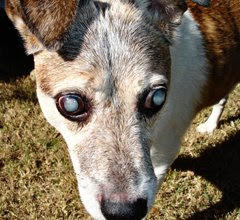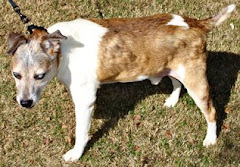A while back, I uploaded a sitemeter so I could track the amount of traffic, but soon found that I could also look at the terms people did searches on. Based on those searches, I have assembled a guide to help other pet owners. Please remember, I’m not a veterinarian, I’m just someone who loved Hunter immensely and am sharing my experiences to help others.
Some people will follow their veterinarian’s advice and their pet will get well. Unfortunately, I did follow their advice and there were a lot of symptoms missed or misdiagnosed and that’s what I write about.
JACK RUSSELL’S & CUSHING’S
A lot of searches have been on whether or not more Jack Russell’s get Cushing’s than other breeds of dogs. I don’t know if that assumption is correct or not, but from what I’ve read online, that even though any breed can get Cushing’s, terriers seem to be more pre-disposed.
FEEDING
I’ll start with one of the basics, feeding your pet. There have been a lot of searches about what to feed a dog with Cushing’s or Diabetes. As Hunter was first diagnosed with diabetes, I was told to put him on a high fiber diet, such as DCO by Purina. When he was diagnosed with Cushing’s, I was never told to take him off of DCO. Since Hunter’s death, I have learned that a diabetic dog should be on high fiber, whereas a dog with Cushing’s should be on a low fiber diet. So, if your pet has both, you’ll want to feed them something in-between. Discuss with your vet your options for feeding.
Besides being a picky eater, Hunter was naturally a grazer. So the trick was to get him to actually eat all his food before I would give him his insulin. Scrambled eggs are safe to give to dogs with diabetes, just be sure not to use any oils, butter, or seasoning. I would scramble a few eggs at a time and keep them in the refrigerator, just heating them slightly in the microwave. I would add a little over a tablespoon to his food.
TREATS & SUPPLEMENTS
Be sure to check the ingredients of all treats and any supplements (vitamins) you give your pet. Hunter had been taking a glucosamine/vitamin chew and I had to stop that as glucosamine is an amino sugar. Also, the majority of the treats had corn syrup or some other sugar based ingredient. Peanut butter used to be a treat and now that was eliminated.
If you do decide to make your own treats, try to include cinnamon, as it helps to lower blood sugar levels. You can also add cinnamon to your pet’s food (either canine or feline) by adding less than ¼ teaspoon for each meal. Also, be sure to only use whole wheat flour. The treats I made with oatmeal and cinnamon looked absolutely awful however, Hunter would still eat them.
I did find two sites that I would order treats for Hunter. One is called Doggies Unlimited. I would order “Maggie’s Apple Cinnamon Delights” and Hunter could smell them before I got the package open and would be begging for one. The other treat is a diabetic dog cookie at Old Dog Cookie Company. They're the perfect size when you don't want to give your pet a large treat. I would give him these when he was good about getting his shots.
*I receive no financial reimbursement for my recommendations of any products listed on this blog.
BENADRYL
I was never instructed not to give Benadryl. Although I had been using the pill pockets, I had to switch back to molding the pills in cheese.
ITCHY SKIN
Hunter seemed to always have itchy skin. I think it was from a mixture of allergies and then later Cushing’s.
Sometimes, he had skin lesions which were thought to have been caused by FAD (flea allergy dermatitis), I found a shampoo and rinse which helped called Malaseb. They also have a concentrated rinse which helped greatly.
As for regular bathing, I must have bought different shampoos a few times a month. I never could find one that soothed his skin and coat. I finally found a shampoo and conditioner that seemed to work for him. Unfortunately, I came across it in the last five months of his life. I found both at Doctors Foster & Smith. The shampoo is called Septi-Soothe, and the conditioner is called Oatmeal Conditioner with oat protein, chamomile, Vitamin E, and borage and evening primrose oils. His coat looked and felt wonderful like when he was a puppy.
Note - You will also see an increase in hair loss due to Cushing’s and diabetes; especially when using Lysodren.
SYMPTOMS OF CUSHING’S
I have written what Hunter’s symptoms were here: http://k9-hunter.blogspot.com/2009/02/reflections.html.
I want to add about the symptom of pigmented skin on the belly. If you're an owner of Jack/Parson Russell, then you're already aware that they have pigmented skin, especially on the belly. I was looking back recently at pictures of Hunter from a few years ago and I noticed how pink/red his belly was. There were no bumps or rash present, but I do remember how warm/hot his belly would feel to the touch. Hunter did suffer from allergies and this could have been a result of that, but I can't help not think that possibly it was also due to Cushing's.
Remember, your pet may exhibit different symptoms at different times. Hunter didn’t start drinking & eating ravenously until after he was diagnosed with diabetes. For him, these two symptoms meant he was in the late stages of Cushing’s. Your pet may be different and these could indicate the beginning signs.
Another possible symptom is restlessness. Hunter would have a hard time at night getting settled. He was constantly getting up and scratching around his bedding and this was especially noticed before he was put on Lysodren. A lot of times I would get up to check on him and he would just be standing. It was like he didn't know what to do. You may possibly notice this in your pet also.
PANTING
I have to stress one symptom in particular that I have seen searched as I feel this was a vital sign that Hunter had Cushing’s and that is panting. If your dog is panting for no reason other than just walking around the house or eating, get a test for Cushing’s; especially if they search for cool surfaces to lie on.
Hunter’s panting was written off as being a symptom of him being a few pounds over weight.
HOT SPOTS
Hunter would get hot spots between his toes. Before he was diagnosed with Cushing’s, he had licked a sore in between his toes that would not stop bleeding. It was so bad, I had to take him to the vet and they cauterized it. However, once treatment began with Lysodren and his cortisol levels were back in the normal range, the hot spots disappeared.
I did find that using plain old witch hazel along with a cortisone cream seemed to help a bit, as Hunter hated tea tree oil.
TREATMENT FOR CUSHING’S
There are four drugs approved for treatment of Cushing’s:
Anipryl (generic Selegiline)
Ketoconazole
Lysodren
Be sure that you discuss the risks thoroughly with your doctor(s). Do your own research on the web as there are many informative sites.
I do have a word of caution about Lysodren, be sure that you know all the risks involved. Of all the medicines, Lysodren has the most serious side-effects, including death. Lysodren can also take your pet to the other extreme called Addison’s Disease where almost all of the adrenal cells in the body have been destroyed. Blood work will show low sodium level, high potassium level, and high kidney enzymes. An ACTH test will give you a more definitive diagnosis.
When we took Hunter to the ER, his blood work came back normal. We feel that Hunter was dying from the Lysodren. Keep in mind even though some dogs have been successfully treated with Lysodren, it is a poison. If I had known how dangerous Lysodren was at the time, I would have only used it as a last resort.
COSTS OF TESTS
I live in Atlanta, GA and the tests were given at GVA (Georgia Veterinary Specialists). The costs were from October 2008, as I’m sure they have since changed. However, you can still estimate the expense.
Initial Exam
The initial exam included an ultrasound of abdomen, a complete urinalysis, two glucometer tests and eye drops. Also, included was the cost of the AlphaTRAK glucometer, lancets and test strips. There was also a consultation by the opthamologist as Hunter had cataracts and his eyes were bulging and inflamed. The total cost was $920.
ACTH Test
Your pet will spend approximately 8 hours at the vet. Your pet will need to fast the night before meaning no food or water after midnight. If you have medicine that has to be given (Hunter had to take L-Thyroxin), go ahead and give it. Hunter would also take Benadryl in the morning and I just skipped that dose. Be sure that you send along food and a syringe with the dosage of insulin if your pet is diabetic. The cost of this test was $205. The cost of the second ACTH test was $160, and the third ACTH test was $146.
AlphaTRAK
I highly recommend purchasing an AlphaTRAK so you can monitor your pet’s glucose at home. The AlphaTRAK is made specifically for animals (dogs & cats). Human meters don't measure the glucose as well.
By the time you’ve taken your pet back to get a glucose curve done at the vet a few times, you could have purchased one yourself. Mine cost me $105, but I’ve seen them on the net for as low as $90. You’ll also need to purchase lancets and test strips specifically for the AlphaTRAK. I talk about getting a sample here: http://k9-hunter.blogspot.com/2008/11/glucose-curve.html along with what numbers are considered in the good range.
One thing I didn’t mention about the AlphaTRAK, is that there will be times where you get an ERR message. It usually happens when your blood sample was a little too small for the strip and it timed out. I would take Hunter’s sample from the bottom of his foot pad and I’ll just say it has to be a good size drop and you have to be fast. However, there were a few times when I would try to reset the meter and nothing would happen. No numbers, no nothing. You’ll need to open up the back where the battery is and take it out and then put it back in. That seemed to fix the problem.
Also, it was never given on any instructions, but I would go ahead and wipe the spot I was going to prick with alcohol. I was just being cautious.
INSULIN SHOTS
Instructions here: http://k9-hunter.blogspot.com/2008/12/update.html.
I want to stress the importance of getting your pet's glucose numbers down. When Hunter first started getting insulin shots, our vets were not aggressive. They would tell me to increase his insulin dosage and get back with them in a few weeks for them to check his glucose. In the meantime, his cataracts were getting worse and Hunter literally went blind in a few weeks.
I learned from the internist that once you increase the insulin dose, it only takes two to three days for the body to adjust to the increased dosage. So, the weeks that I was told to wait by our regular vets was unnecessary. I can’t stress this enough, but your vet needs to be treating the diabetes aggressively. If your vet is making you wait, like mine did, for weeks before increasing the dosage, challenge them. Also, be sure that you keep a watchful eye for hypoglycemia and have your corn syrup handy. A reminder be sure the insulin is at room temperature as cold insulin shots hurt.
STOPPED EATING
If your pet has stopped eating and you need to give them a shot of insulin, the reason is either one of two things. They’ve become stubborn about eating or they’re starting to go downhill. You can distinguish which way it is by how they are behaving. Are they still energetic? Or, have they become withdrawn?
If they are still energetic, you can try these foods. Remember, no oil, butter, or seasoning, but you can try garlic. First try scrambled eggs or poached eggs with runny yolk. If this doesn’t work, consider boiling some chicken or make brown rice. Don’t use white rice as it will raise their sugar levels.
If you still can’t get your pet to eat, call your vet or an emergency vet hospital. It’s very dangerous to give them an insulin shot with no food as it will cause their sugar level to drop dangerously low and can cause them to die.
If you’ve gone ahead and have given them a shot of insulin, watch their behavior closely. If they become lethargic and when you call them they don’t move, give them some corn syrup (Karo) immediately by rubbing the syrup on their cheeks and gums. Don’t try to get your pet to drink it as they could be having a convulsion and may bite you. You’ll need to rush your pet to the vet’s or an ER.
NON-TREATMENT FOR CUSHING’S
If you decide not to treat your pet for Cushing’s for whatever reason, be sure that you are well informed as to what your pet will go through.
My sister has a friend whose pet died from Cushing’s. Unfortunately, this was not a choice for my sister’s friend, as her vet failed to inform her that she had treatment options. What was even more upsetting was the fact that Lydia most likely got Cushing’s due to her using steroids for her arthritis. If the steroids had been decreased, most likely her cortisol levels would have returned to normal.
Besides diabetes, your pet can die from congestive heart failure, liver and kidney failure, neurological disorders such as, seizures and coma. Lydia died while having a seizure.
UNDIAGNOSED CUSHING'S
This is the biggest problem about Cushing's. Most times, by the time your vet has finally diagnosed your pet with Cushing's it is too late. If your pet has all or a majority of the symptoms of Cushing's and your vet tells you that it's due to their age and that little nagging feeling comes, follow your instincts. Make your vet do a Cushing's test.
This was the most painful part when Hunter was diagnosed. Through research, we were able to put together that Hunter had developed diabetes because of his undiagnosed Cushing’s. I have read recently that by the time they develop diabetes, they have passed the point of no, but you still want to try to make them better. For Hunter, he went downhill really fast.
CUSHING'S & UNCONTROLLED DIABETES
I hate to add this, but I feel some of you will need to be prepared. Once we got Hunter’s Cushing’s under control, even for a little while, his diabetes was finally under control. I have corresponded with several people and a common theme was that everything seemed to be going well and then all of a sudden their diabetes went to being uncontrolled again. In each case, this happened in the last few weeks of life.
LENGTH OF LIFE
Several people have searched on how long does a pet live with Cushing’s and diabetes. I only have Hunter’s experience to go by and he only lived for five months. He was diagnosed with diabetes in July and finally Cushing’s in October.
We believe strongly that Hunter had undiagnosed Cushing’s for a good three to four years previous. However, when he went on to develop diabetes he was in his final stages. This is why I am stressing the importance of early diagnosis of Cushing’s. I can’t help but believe if he had been properly diagnosed with Cushing’s and treated, he would have lived longer and never would have developed diabetes.
END OF LIFE (End Stages)
This is one of the hardest decisions to make. If you are thinking about when to end a life, try to remember it is no longer about your feelings or your loss, it is about their comfort.
When Hunter looked his worse back in September, I could still see in his eyes that he still had the fight in him. However, on December 26th and when he came home for the last time on the 28th, the fight was gone and he looked sad and tired. I knew at this time he was never going to get better and I did not want him to die while having a seizure or going into a coma. I felt hope was gone and the doctor confirmed it for me.
I subscribe to a magazine from Best Friends (www.bestfriends.org) and in July (2009) there was an article on Veterinary Hospice: End of Life Care. One part of the article struck me, “For other people who desire a natural death for their pet, we walk them through what that death might look like. In many disease conditions, the death is not peaceful, and we have to have pretty frank conversations about that. Euthanasia is a controlled process and, done appropriately, is peaceful. Natural death is completely unknown, and that makes some vets uncomfortable. They’re worried about the animal’s welfare and the client’s welfare." If there is still time, I sincerely hope that people will consider giving their beloved pet a peaceful death.
My aim for starting this blog changed when Hunter lost his battle. I hope this blog will help you with asking questions of your doctor that you might not have thought of. Also, please use your gut instincts and be sure to voice your concern if something you are told just doesn’t feel right.
One last suggestion start a blog, write a book or go to pet boards and tell your pet's story. Get the message out about the devastating effects of Cushing's.
Subscribe to:
Posts (Atom)



